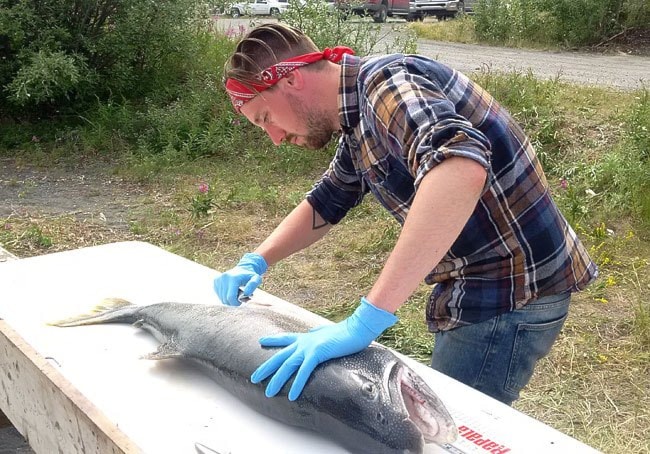Heidi Swanson is delighted with the early results of contaminant testing on Kluane Lake fish. The lake trout and whitefish have extremely low levels of mercury, a common contaminant in northern lakes.
“It’s a good-news story,” the University of Waterloo biologist said in a December interview. “I mean, you could have knocked me over with a feather when I saw the results!”
Swanson and her students are studying levels of contaminants in Kluane Lake food fish species as part of the Kluane First Nation’s food security strategy. With traditional terrestrial food sources, such as moose, declining, the First Nation is looking to the lake for future food security, she said.
The first test results are based on 115 samples from fish caught in the Kluane Lake Trout Derby last July. Successful fishers donated samples of flesh from their fish, as well as a small bone called an otolith that can provide information about the fish’s age. The results came back just before a couple of major northern science meetings in Vancouver, and the researchers scrambled to put together a poster summarizing them.
“We were not expecting at all the results we got,” said Swanson. “The Kluane Lake fish are really low in mercury - both the whitefish and the lake trout. Almost all of the fish are below the subsistence consumption guidelines, which is amazing.”
Mercury is a common contaminant in most northern lakes, she said. It mainly comes from thousands of kilometres away, drifting high in the atmosphere and settling out over northern land and waters. Small fish consume it with their food, and it accumulates in their bodies. Large fish eat the smaller fish, and more mercury collects in the larger fish. If people then eat the larger fish, the mercury accumulates in their bodies too and can cause serious health problems.
“The lakes are cold and not productive, and the fish grow really slowly, and when fish grow slowly they tend to accumulate more mercury,” Swanson said. In many northern lakes, large predatory fish like lake trout carry substantial amounts of mercury, which limits how many fish people can safely eat.
But not in Kluane Lake. All the fish tested were well below the levels specified for commercial sale, and all but a couple were below the mercury levels set out for safe subsistence use. The few higher-testing fish were large and old, almost a metre long, and not the smaller, tastier fish most people prefer, Swanson said.
She’s not sure why the Kluane Lake fish should have such low levels of mercury. Analysis of sediment cores taken last year from the lake bottom might provide some clues. That analysis will happen this spring. But Swanson thinks what the researchers found in the stomachs of the fish might be an even better clue.
“Almost all of them were completely full of snails, which is unusual for lake trout.” If that’s one of their dominant prey items, she said, it would explain why they have low mercury. Snails graze on vegetation and algae in the lake, so they don’t accumulate mercury to the degree that carnivorous fish do. If the lake trout are eating snails rather than smaller fish, they’re picking up far less mercury in their food.
Swanson said her group still has plenty to learn about the feeding habits of the lake trout and whitefish in Kluane Lake before they can fully understand the results. But overall, the picture is good.
“Basically, it’s a good-news story. The lake has much lower mercury than I ever would have predicted after 15 years of work in the Canadian North on mercury.”
The project is not finished. The samples are being tested for other contaminants, such as pesticides and PCBs. And Environment Yukon has contributed more samples, archived from previous years. In addition, the Kluane First Nation is collecting samples from their traditional winter fishery for burbot.
In the meantime, Swanson said, people shouldn’t worry about eating Kluane Lake fish, and the First Nation’s future food supply looks promising.
“Really, I’ve never seen such safe fish to eat in the North. I’m flabbergasted, in a good way.”
The Kluane Lake fish research is a co-operative effort by the Kluane First Nation, the Arctic Institute of Community-based Research, and the University of Waterloo researchers. The poster outlining the first results of the study is available on the Kluane First Nation’s website at www.kfn.ca.
Claire Eamer moved to the Yukon in 1984 for a couple of years and finally got around to moving south (to Gabriola Island, B.C.) in 2015. Her latest book for kids, Before the World Was Ready: Stories of Daring Genius in Science, won the Lane Anderson Award for Young Readers, given for Canadian science writing.
